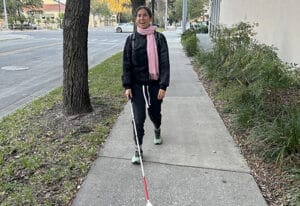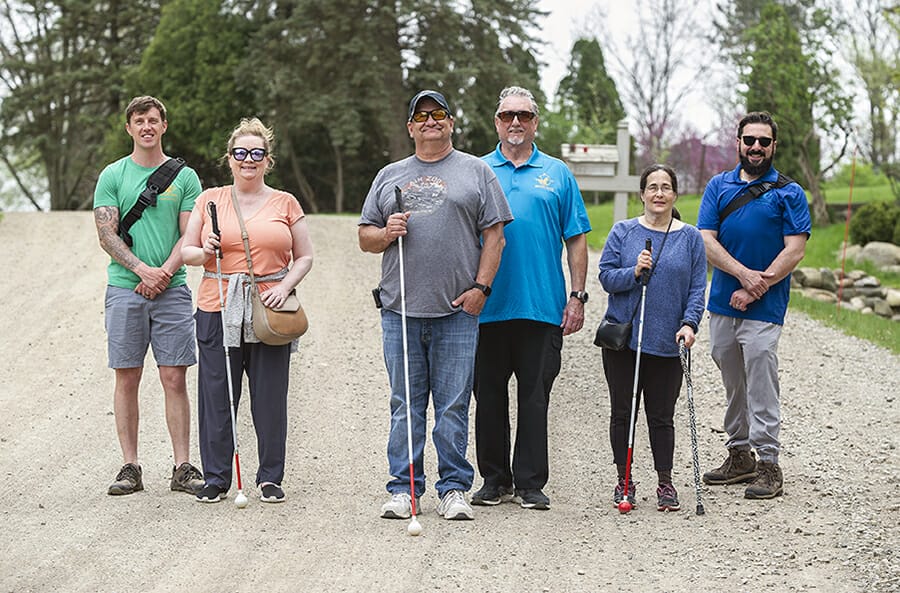
You may not have heard of “orientation and mobility” or “O&M” before, but you’re probably familiar with the concept of someone who’s blind traveling with a white cane. Orientation and mobility (O&M) is how we refer to the training people receive to navigate with a white cane successfully. Let’s break it down.
The “orientation” in O&M is knowing where you are in space or in relation to other people and objects. When we’re talking about orientation when working with someone who is visually impaired, we’re referring to the individual knowing where they are, where they are going and how they’re going to get there. Orientation is important because when traveling from point A to point B, you always need to know where you are within the route so you can anticipate your next move and get to the correct destination.
“Mobility” focuses on the action of moving through space safely. In addition to the long white cane, there are different kinds of tools that someone who is blind can use to help them physically navigate their environment. Learning to use these tools successfully is the other key part of O&M.
To summarize: orientation and mobility is knowing where you are in space while maneuvering through the environment safely, typically with the help of a long white cane.
How does the white cane work?
 To start, let’s talk a little bit more about the cane itself. The long white cane is a mobility tool to help someone who is visually impaired navigate the environment safely. It helps to think of the cane as an extension of your body. If you reach out to touch something, you’re seeking sensory input that will help you find out more about your environment. The cane is essentially reaching out for you, letting you know that there’s a crack in the sidewalk, you’re heading onto a different surface (maybe veering off the sidewalk into grass), there’s an obstacle ahead that you’ll need to go around, and so on.
To start, let’s talk a little bit more about the cane itself. The long white cane is a mobility tool to help someone who is visually impaired navigate the environment safely. It helps to think of the cane as an extension of your body. If you reach out to touch something, you’re seeking sensory input that will help you find out more about your environment. The cane is essentially reaching out for you, letting you know that there’s a crack in the sidewalk, you’re heading onto a different surface (maybe veering off the sidewalk into grass), there’s an obstacle ahead that you’ll need to go around, and so on.
There are different techniques to using a cane, but these typically include sweeping or tapping it back and forth as you move. This lets you interpret the ground ahead through physical sensation as well as sound. Listening to what the cane touches not only tells you a lot about the surface you’re navigating but also about the wider environment you’re in. For example, when tapping the cane, the sound feedback can be used to determine how big or small a room is, if there is an opening in a hallway or if you are approaching a wall. The sound of the tapping will be different based on the environment.
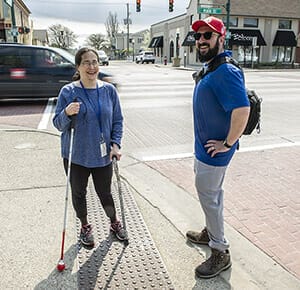 Have you ever noticed the bumps on the ground at the end of a sidewalk or when exiting a grocery store? These are called tactile domes, and they’re a tool for people traveling with a long cane. The user can detect those bumps through the cane and know that those represent a choice is coming up or to proceed with caution as typically they’ve arrived at a street or parking lot. These tactile domes are incredibly useful for people traveling with a cane!
Have you ever noticed the bumps on the ground at the end of a sidewalk or when exiting a grocery store? These are called tactile domes, and they’re a tool for people traveling with a long cane. The user can detect those bumps through the cane and know that those represent a choice is coming up or to proceed with caution as typically they’ve arrived at a street or parking lot. These tactile domes are incredibly useful for people traveling with a cane!
White canes can be made of aluminum, graphite, fiber glass and a few other materials. Some long white canes can be folded or collapsed while others are considered rigid canes and don’t break down.
White canes come with a variety of cane tips. We like to think of cane tips the same way you think about shoes. You probably wouldn’t wear hiking boots to the beach or flip flops on a hike. It’s the same with cane tips. One cane tip may be more appropriate for a certain environment than another. Typically, cane tips can be switched out easily and are small enough to carry an extra in a bag or pocket if need be.
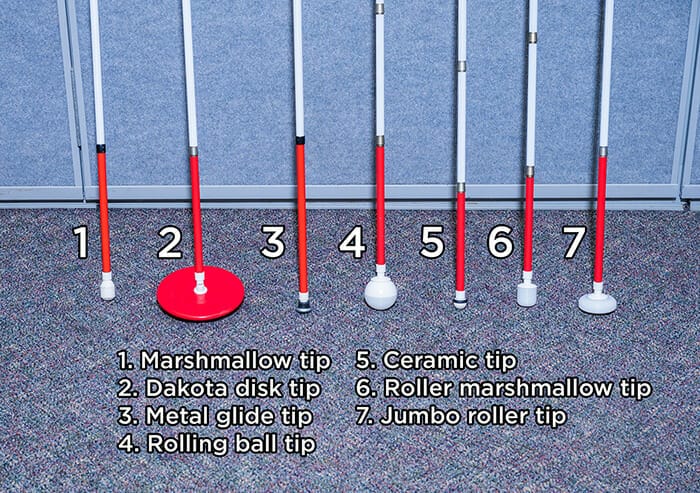
Another unique fact about the long white cane is that it is not a one-size-fits-all tool. A certified orientation and mobility specialist (often referred to as a COMS) will prescribe the correct cane length based on a client’s height and pace.
The long white cane is a unique tool that with practice can be incredibly useful in traveling safely without vision. People who travel with a cane can and do travel completely independently!
When to consider using a cane
 Now that we have a better understanding of what orientation and mobility is and how the white cane works as a mobility tool, how do you know if you’re ready for the white cane?
Now that we have a better understanding of what orientation and mobility is and how the white cane works as a mobility tool, how do you know if you’re ready for the white cane?
Recognizing when someone is ready to start using a white cane is going to be completely different for every person. It depends on how they’re feeling and when they start to notice difficulties. Vision is incredibly tricky. Some people may have good days where they feel they can see quite well because the lighting is great or there’s really good contrast and then other days where things seem worse and they wonder if tomorrow it might all be gone. Someone could also experience those same thoughts all in one day where their vision continues to fluctuate regularly. There are many variables that are constantly changing and that can impact vision, but let’s talk about some things an individual may start to notice.
Here’s a list of questions to ask when you’re determining if a cane is right for you:
- Have you started to notice that you are missing level changes on the ground, missing a step or not noticing a dip in the sidewalk or parking lot?
- Are you beginning to catch your shoulder on walls or door frames because you aren’t able to see them as well, or you’ve lost more of your side vision?
- Do you have more difficulty finding something that you’ve dropped as it now blends into the floor?
- Are you no longer comfortable traveling at night and feel you are missing out on fun events because you are nervous to travel at night?
- Are you noticing difficulty distinguishing fine detail such as people’s faces or when reading?
- Do you find that you are depending more and more on family or friends or finding that you don’t want to go places alone?
- Have you been in uncomfortable situations such as bumping into someone and them not understanding that you couldn’t see them or that you have trouble seeing?
These are just a couple of examples of things that may start to happen or may already be happening to you.
Let’s briefly talk about some of the pros and cons of using a long white cane.
Cons or some of the stigmas of cane use:
- People know you are blind or that you have a disability.
- People tend to shy away from people with a cane because they are nervous or don’t know what to do.
- People always assuming you need help or assistance.
- It’s one more thing to carry around with you.
Positives and the benefits of using a cane:
- People know you are blind or have a visual impairment: now when you accidentally bump into someone at the grocery store or don’t recognize someone, they will understand, and I guarantee you they will be the one to apologize or approach and say hi.
- You can advocate for yourself and others with visual impairments, educate someone on what it means to be blind and that most people who are blind do still have some remaining vision.
- People will recognize that you may need assistance and offer some help picking out bananas or crossing a busy street.
- You can travel and move about safely and independently knowing you have a tool to assist you. The cane really does become another set of eyes and helps you interpret the environment.
As you can see, many of the cons are also positives depending on how you think about them. Ultimately, it is your decision and safety that matters!
Orientation and Mobility at Leader Dog
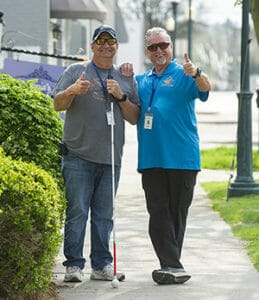 In January of 2002, Leader Dog started our very own Orientation and Mobility program to help individuals increase skills and meet their goals of traveling independently, whether that be with a white cane or a guide dog. One of the best parts about our O&M program is that you do not have to be interested in a guide dog to qualify for O&M.
In January of 2002, Leader Dog started our very own Orientation and Mobility program to help individuals increase skills and meet their goals of traveling independently, whether that be with a white cane or a guide dog. One of the best parts about our O&M program is that you do not have to be interested in a guide dog to qualify for O&M.
Our Orientation and Mobility program is a one-week, typically residential program with one-on-one instruction from a certified orientation and mobility specialist. Throughout that week of training, individuals typically receive between 25‒30 hours of direct instruction. The week is completely individualized, and training takes place in numerous environments. The O&M program has no skill or vocation requirements and is available to anyone 16 years or older. We offer multiple options for our O&M program, which are covered below.
Here are a few of the skills you may cover in a week of O&M at Leader Dog:
- How to open and close a long white cane
- How to go through a door with a cane
- Where to put a cane during meals
- Human Guide techniques
- Basic cane techniques
- Orientation concepts
- How to locate a curb or drop off
- How to analyze and cross a street
- How to navigate a mall
- And so much more…
O&M options at Leader Dog
People come to our O&M program with different skill levels, different travel environments and different goals, so we’ve broken our training up into a couple of different options to address these different needs. However, these categories are to help an applicant understand all that we can offer at Leader Dog. Ultimately the week is completely based on YOUR goals and skills and will most likely be a combination of more than one training option.
Introduction to O&M:
- Ideal for individuals who have received little to no training
- A great selection for someone who has never traveled with a cane before and is wondering if now is the time to work with one
- All clients will be given a cane and have the opportunity to try an assortment of cane tips in various environments
O&M Brush-Up:
- Ideal for individuals who have had formal training in the past and wish to increase or refresh their independent travel skills
- Perfect for those who have had a change in their travel environment or vision since their last training
- A great option for long-time guide dog users who are seeking to brush up their cane skills
Guide Dog Readiness:
- Ideal for individuals who want to learn more about the skills required to successfully work with a guide dog
- A great selection for those wondering if a guide dog is a good fit for their lifestyle or travel environment
- *This class does not guarantee acceptance into guide dog training*
Advanced O&M:
- Ideal for individuals who are seeking to travel more confidently in difficult environments
- Perfect for someone who wants to analyze complex intersections
- A great selection for someone who frequently travels in unfamiliar environments
In-Home O&M:
- A certified O&M specialist provides one-on-one instruction in the client’s home environment. Training duration is up to 5 days
- Clients can continue to care for their families and fulfill some work commitments during evening hours
- Focuses on client’s standard routes to work, school, medical appointments, etc.
- Works around personal and/or family health issues
Youth O&M:
- Ideal for 16- and 17-year-olds ready to take O&M skills to the next level of independence
- A great selection for a family member of a youth who is visually impaired to learn how to support and encourage the development of O&M skills
- Perfect for someone who wants to continue practicing O&M skills when not in school during the summertime
What are some things you can expect during a week of O&M at Leader Dog?
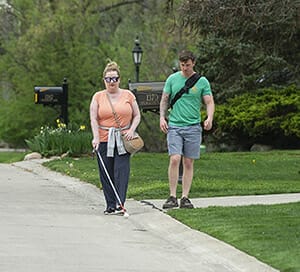 The schedule is pretty consistent throughout the week, but there is plenty of flexibility if need be. Clients arrive on Sunday afternoon and typically depart the following Saturday.
The schedule is pretty consistent throughout the week, but there is plenty of flexibility if need be. Clients arrive on Sunday afternoon and typically depart the following Saturday.
Breakfast is usually at 7:30 a.m. every morning.
The first lesson of the day starts around 8:30 a.m. and goes until about 11 to 11:15 a.m. depending on where you are and what you’re working on.
Lunch is at noon. The second lesson of the day starts at 1 p.m. and usually goes until about 3 to 3:15 p.m.
Dinner is at 5:30 p.m. and typically you have the nights to yourself. We do offer a night lesson if that is something that you would benefit from, but that’s something you can address with your instructor.
More details:
- You’ll work one on one with a certified orientation and mobility specialist and will work with the same instructor throughout the entire week.
- There will most likely be other O&M clients and guide dog clients in the building at the same time, so it’s a great opportunity to meet others and share tips and tricks.
- We do go outside and train in all weather conditions so be prepared to be in the rain, snow and sunshine!
- You will not go hungry. Our kitchen and resident assistants are wonderful and provide delicious meals and accommodations.
- Please do not expect to be an expert cane traveler in 5 days. These skills take time and a lot of practice!
Just know that the week of O&M at Leader Dog will be whatever you need it to be! Your instructor will work with you to create realistic goals for yourself and move at a pace you are comfortable with.
You can start your application for O&M here or find out more about O&M at Leader Dog on our website. We welcome your questions! Email us or give us a call at 888-777-5332.

